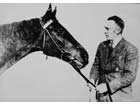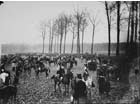Sport/Great Pardubice Steeplechase (Velká pardubická)
The history of the Great Pardubice Steeplechase of Česká pojišťovna (Czech Insurance Company)
The different sources used to mention that The Great Pardubice Steeplechase is the hardest steeple chase on the continent. It may certainly be true to some extent, in any case it is a horse racing competition with a long tradition, the history of which is more than interesting. This is a race having its specific features and charms, and it is a peak for Czech riders dreaming, if not of winning, at least of taking part in it. In any case this is a social and sporting event with the longest tradition here. Actually, when the football league started to be played, the “Great” was already enjoying about fifty-years in existence.
The Great Pardubice Steeplechase was run for the first time in 1874. But horse races had been held in Pardubice and adjacent localities already a few tens of years before. The whole horse racing world knew Pardubice from the very beginning, because a number of trainers and jockeys from England, the cradle of turf, were engaged in central Europe.
The race course in the places it is run now was founded in 1856. It has had its present appearance since the first post-war years. Formerly, horses used to run as far as to Popkovice and also behind the grandstands in the area of the current parking lot. After the World War II was over, a military airport was established here and the army occupied certain parts of the land.
The course of the race has been changed several times over history, last time it was in 1998, when the final stage of the race along the main racecourse was run in the opposite direction for the first time. Finish relocation and the change in the direction from the right-hand side is closely connected with construction of the new grandstand. The main route is 2200 metres long in total, and the track of the Great Pardubice Steeplechase measures approximately 6900 metres. Horses must overcome the total number of 33 fences. The Taxis ditch, which is also one of the most difficult jumps in the world, is the best-known one. In the course there are some other hard fences often deciding on the success or failure of individual contestants. They include e.g. the Irish bench, Popkovice jump, French jump, snake ditch, big water ditch, gardens, big English jump and Havel’s jump.
The racecourse surface is mostly covered with grass, but partly crosses a ploughed area, the share of which was considerably reduced in certain periods, however. In the first decades the ploughed areas formed nearly one half of the racecourse, later about one third and now about one fourth. Some of the fences were also modified so that the safety of horses and riders was increased. Last time it was water ditches that were changed most as concrete bowls were built in the original natural water course. The safety was increased but the difficult nature “suffered” as a result. The big water ditch decided on the winner many a time, now this fence is easy to overcome and may be even run through. The big water ditch was also modified when it was partly filled up but its basic parameters were not changed.
From 1874 till 2008, 118 years of the Great Pardubice were run, the last one on Sunday 12 October 2008. It only did not take place during both world wars, and once it was prevented by adverse weather conditions when the day before it started freezing and there was snowfall; furthermore the Great Pardubice Steeplechase did not take place in 1968 as a result of the well-known political events.
The first winner was FANTOME/PHANTOME, born in France, with jockey Sayers in the saddle. ŽELEZNÍK, the sorrel that was the only horse that managed to win four times – in 1987 – 1989 and also in 1991, is the most successful horse in history. Six horses managed to win three times: BRIGAND in 1875, 1877 and 1878, LADY ANNE in 1891, 1894 and 1896, EPIGRAF in 1957–1959, KOROK in 1969, 1971 and 1972, SAGAR in 1981–1983 and PERUÁN in 1998–2000. Twelve other horses were recorded in the winners’ list twice. They include e.g. mare REGISTANA as well as MASKUL.
As for riders, Josef Váňa managed to win five times, four times with ŽELEZNÍK, and with bay horse VRONSKY in 1997. Václav Chaloupka has four triumphs in his collection, three with KOROK and one with VÁCLAV in 1978. In 2008, one of 56-year-old Váňa’s dreams came true – he appeared at the starting line together with his son, Josef Váňa junior. In that year Josef Váňa senior came third and his son was fifth. The excellent German jockey Peter Gehm has the same number of successes recorded as Váňa senior; he was the partner of bay horse CHALCO in 2001, a year later he won in the saddle on MASKUL and recorded victories with REGISTANA in the next two years Peter Gehm is the only jockey who managed to win the Great Pardubice Steeplechase in four consecutive years.
Six riders have three victories in their collections, the first one being Hector Baltazzi, Italy, just at the beginning of the race history, the three English riders – Fletcher, Buckenham and Geoghegan – managed to achieve the same success, Pavel Liebich in the saddle on SAGAR won three times in early 1980s, and Zdeněk Matysík riding PERUÁN won the last three years of the last century. Fifteen jockeys won twice, e.g. Vladislav Snitkovskij in 1994 and 1996, his partners being ERUDIT and CIPÍSEK.
A few women have also taken part in the race in the course of its history. The first one was Lata Brandisová, who even won with mare NORMA in the last year before the war – in 1937. In the 1960s Eva Palyzová took part in the race regularly; she managed to come to the finish line successfully in 1965 and 1971 – came second with Cavalet and Metál. Other women followed – Englishwoman Charlotte Brew, Jana Nová, R. Charvátová, Martina Růžičková. The last amazon, seventh so far, was Lucie Baluchová, who came third with Gretty in 1997.
The time record holder was MASKUL that finished the whole race in 2005 (115th year) in 09:11.25 minutes. But the winner – mare Sixteen with the jockey Bartoš overcame this record in the 118th year – her time was 8:58.99 minutes. In the post-war period, when the racecourse underwent essential modifications, the best ever-recorded time was that of French ROYAN DE LUNE, the 1947 winner, his time was later overcome by GRIFEL in 1961, by GABOJ a year later and by the English horse STEPHEN´S SOCIETY in 1973. In 1987 ŽELEZNÍK ran the race in 9:56.13 – the first result below 10 minutes. Already three years later, on the occasion of the one hundredth jubilee of Great Pardubice it was LIBENTÍNA that ran the race in 9:49.4. This record only lasted till 1996, when CIPÍSEK won in a time of 9:35.00. Then this time was overcome twice by PERUÁN and REGISTANA. The aforementioned Sixteen is the last record holder. It is true that the achieved time is a proof of the winner’s qualities but it rather often depends directly on the weather and the racecourse condition. Individual years were also affected by course changes, therefore the winner’s time is more or less statistical and no conclusions may be reached from it. Disqualification of Amant Gris, winner of the 118th year due to his failure to run around the turning point, which was only the second disqualification of the winner in the Great Pardubice Steeplechase history, is also worth mentioning.
At the beginning of its history, the starting fields were not numerous, often just a few horses, in fact only three brave ones ran once. Horses were mostly of foreign origin, most of them German, English and Hungarian. As for jockeys, it was the same. This is why English, German and Italian names appeared on the winners’ lists in the first decades. The first Czech won the race only in 1902 – it was Ulrich Rosák.
In addition to the current, still active participants in the horse racing business, jockeys Josef Váňa and Václav Chaloupka, other famous and well-known names may be found on the winners’ list, e.g. Rudolf Popler, a native from Vysoké Mýto, who lost his life tragically on the Pardubice racecourse, Lata Brandisová, Miloš Svoboda, a native from Přelouč and historian of the Great Pardubice, Voloďa Prachov, a Russian trainer engaged in Pardubice some time ago, and also František Zítek, the name of a later multiple flat racing champion and trainer. George Williamson, an Englishman who is the only jockey that managed to win both in the Great Pardubice Steeplechase and in the Grand National Steeplechase in Liverpool, is also worth mentioning.
The most successful trainer is MVDr. Čestmír Olehla, whose horses won six times (ŽELEZNÍK four times and REGISTANA twice), František Holčák can boast of five successes (VALENCIO, LIBENTÍNA, RIGOLETTO, ERUDIT and MASKUL), Ing. Václav Chaloupka (KOROK three times, VÁCLAV once) and Václav Čermák (SAGAR three times, FESTIVAL once) have been successful four times. Lenka Horáková is the first woman-trainer with PERUÁN being the horse of her fate. Josef Váňa was also successful as a trainer (CIPÍSEK, VRONSKY, CHALCO, DECENT FELLOW and SIXTEEN).
The most successful riders in the history of the Great Pardubice Steeplechase:
Josef Váňa, Václav Chaloupka, Petr Gehm, Richard Fletcher, E.Georghegan, Hector Baltazzi, Pavel Liebich, Zdeněk Matysík, T.H. Buckenham
The most successful horses in the history of the Great Pardubice Steeplechase:
Železník, Lady Anne, Peruán, Epigraf, Brigand, Sagar, Korok, Mor, Var, Maskul, Victoria, Land Graf II, Grifel, Herold, Magyarád, Jour Fix, Remus, Alphabet, Registana a Sixteen
The best reached times of winners under the limit of 10 minutes:
| SIXTEEN | 2008 | 8:58,99 |
|---|---|---|
| MASKUL | 2005 | 9:11,25 |
| REGISTANA | 2004 | 9:15,48 |
| PERUÁN | 1999 | 9:16,00 |
| PERUÁN | 2000 | 9:29,00 |
| REGISTANA | 2003 | 9:30,14 |
| CIPÍSEK | 1996 | 9:35,00 |
| LIBENTÍNA | 1990 | 9:49,40 |
| ŽELEZNÍK | 1987 | 9:56,10 |



.jpg)
.jpg)
.jpg)
.jpg)
.jpg)
.jpg)
.jpg)